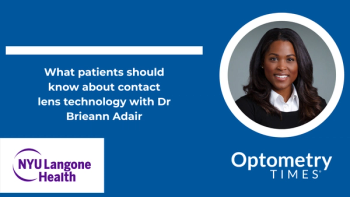
A different approach to treating demodex blepharitis
You see them year after year in your chair: persistent cylindrical dandruff (CD), red lid margins, and eyelash distention. You've prescribed lid scrubs with baby shampoo, warm compresses, and even steroid/antibiotic combo drops, but nothing seems to resolve the condition. If this is the case, it's likely you are dealing with demodex blepharitis.
You see them year after year in your chair: persistent cylindrical dandruff (CD), red lid margins, and eyelash distention. You've prescribed lid scrubs with baby shampoo, warm compresses, and even steroid/antibiotic combo drops, but nothing seems to resolve the condition. If this is the case, it's likely you are dealing with demodex blepharitis. Research indicates that demodex is present in all, or at least most, cases of anterior blepharitis.1
Studies have shown that cylindrical dandruff is pathognomic for demodex,1,2 while conventional wisdom holds that blepharitis is staphylococcal or sebhorreic.3 This represents a paradigm shift and requires a different approach to treatment.
While the aforementioned conventional treatment options can clean up the mess and decrease some signs of blepharitis, none are toxic to demodex, and the condition will persist.4 While new treatments under consideration include topical or oral ivermectin and Greenbug for People cedar oil, a new treatment paradigm is taking shape, and tea tree oil is at the heart of it.
Related:
Left untreated, or poorly managed, chronic blepharitis has many adverse effects-it causes allergy, inflammation, lash loss and misdirection, telangiectasia, and may play a role in meibomian gland dysfunction.5
Before starting treatment
Some things to consider before initiating treatment:
• Anterior segment photographs are useful to monitor progress and to educate patients.
• You can epilate lashes and show the mites to your patients, which should increase treatment compliance.
• Consider using an allergy survey, such as total ocular symptoms score (TOSS) to monitor subjective improvement.
• Because macadamia nut oil will be used in-office, ask about nut allergies.
Related:
It is important to set expectations and educate patients. I explain that demodex is a ubiquitous mite. All adults have some mites, but if we see blepharitis, they simply have too many. In fact, recent analysis of 100 consecutive patients in my practice showed more than 25 had demodex blepharitis confirmed with a microscope. The goal of the treatment is to decrease, not eradicate, the mite population. Tell patients that demodex is a chronic but manageable condition. Long-term eyelid hygiene will be required.
I classify patients as mild, moderate, or severe based on quantity of cylindrical dandruff (CD). I use a relative scale of 0-3:
• 1 is mild, with CD present on fewer than 5 lashes
• 2 is moderate, with CD present on 5-9 lashes
• 3 is severe, with CD present on 10 or more lashes.
You may develop your own scale. I treat patients based on signs, not symptoms.
Treatment
My current, but evolving, treatment algorithm is based on the advice of Mario Gutierrez, OD, of San Antonio, TX.7
Mild cases are prescribed at-home treatments that involve tea tree oil lid wipes twice a day and tea tree oil shampoo and facial wash. Cliradex by Bio-Tissue is currently my lid wipe of choice. Moderate to severe patients are treated weekly in-office with tea tree oil for 3 consecutive weeks at a minimum and use tea tree oil lid wipes twice per day at home. In addition, every 3-6 months I treat severe patients with Rysurg’s new BlephEx device (see “New products help provide treatment”).
Related:
Tea tree oil lid wipes can have an intense sensation that diminishes over time. I advise my patients to think of a cooling vs. a burning sensation. We demonstrate this in-office, so patients know what to expect. Patients are instructed to use the wipes on the eyelashes, forehead, eyebrows, and cheeks because the mites live in these places as well.
This is my in-office treatment protocol:
• Testravisc (tetracaine, Ocusoft) drops are applied prior to treatment.
• Sit the patient behind the slit lamp.
• With the patient looking away from the lid you are working on, use a cotton swab to apply a 50-50 mixture of tea tree oil and macadamia nut oil to the base of the eyelashes. Try to loosen the CD.
• Control the lid with one hand, and apply the tea tree oil mix with the other, being careful to avoid the cornea.
• The patient should sit with his eyes closed for 10 minutes.
• Reapply the mixture and have the patient sit with closed eyes for another 10 minutes.
• Rinse the patient’s eyes thoroughly.
I reassess all patients after 1 month. Some patients, especially those with dense eyelashes or heavy CD, may require more treatments. Once the blepharitis is under control, patients are continued on tea tree oil lid wipes at home on daily basis and followed in 2-3 months.
All patients are given information sheets about blepharitis as well as homework, such as discarding makeup, using hot water, and drying linens on the high dryer setting. Family members should also be evaluated, and treated if needed, for demodex.
Due to recent dermatological research showing a link between demodex and rosacea,8 the mite has once again come into the spotlight. I have found that diagnosing and treating these patients has them looking and feeling better. Many treated patients have commented that their eyes haven't felt this good in a long time.
More on demodex:
References
1. Gao Y-Y, Di Pascuale MA, Li W, Liu DT, et al. High prevalence of ocular Demodex in eyelashes with cylindrical dandruff. Invest Ophthalmol Vis Sci. 2005 Sep;46(9):3089-94.
2. De Venecia AB, Siong RLB. Demodex sp. Infestation in anterior blepharitis, meibomian-gland dysfunction, and mixed blepharitis. Phillipine J Ophthalmol. 2001 Jan-June;36(1):15-22.
3. Benitez-del-castillo JM, Lemp MA. Anterior blepharitis. Ocular Surface Disorders. JP Medical Publishers. 2013:133.
4. Leibowitz HM, Capino D. Treatment of chronic blepharitis. Arch Ophthalmol. 1988 Jun;106(6):720.
5. Horwath-Winter J, Rabensteiner DF, Schwantzer G, Bolden I, et al. The lid margin and Demodex. Acta Ophthalmologica. 2012;90(249):0
6. Coston TO. Demodex folliculorum blepharitis. Trans Am Ophthalmol Soc. 1967;65:361-92.
7. Gutierrez M. Demodex infestation requires immediate, aggressive treatment by doctor, patient. PCON. 2011 June;17(6).
8. Jarmuda S, O’Reilly N, Zaba R, Jakubowicz O, et al. Potential role of Demodex mites and bacteria in the induction of rosacea. J Med Microbiol. 2012 Nov;61(Pt 11):1504-10.
Newsletter
Want more insights like this? Subscribe to Optometry Times and get clinical pearls and practice tips delivered straight to your inbox.



















































.png)


